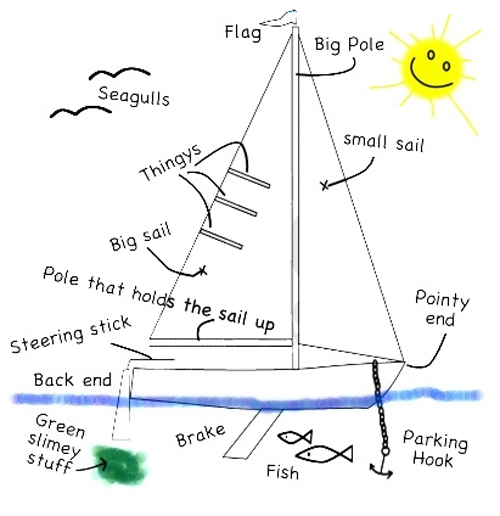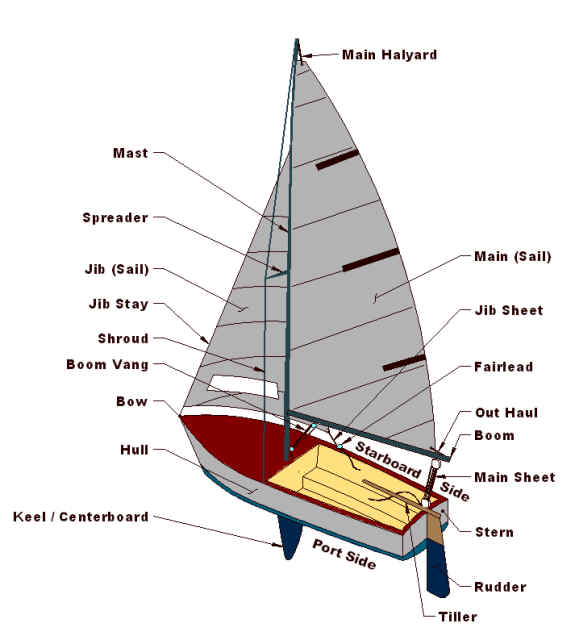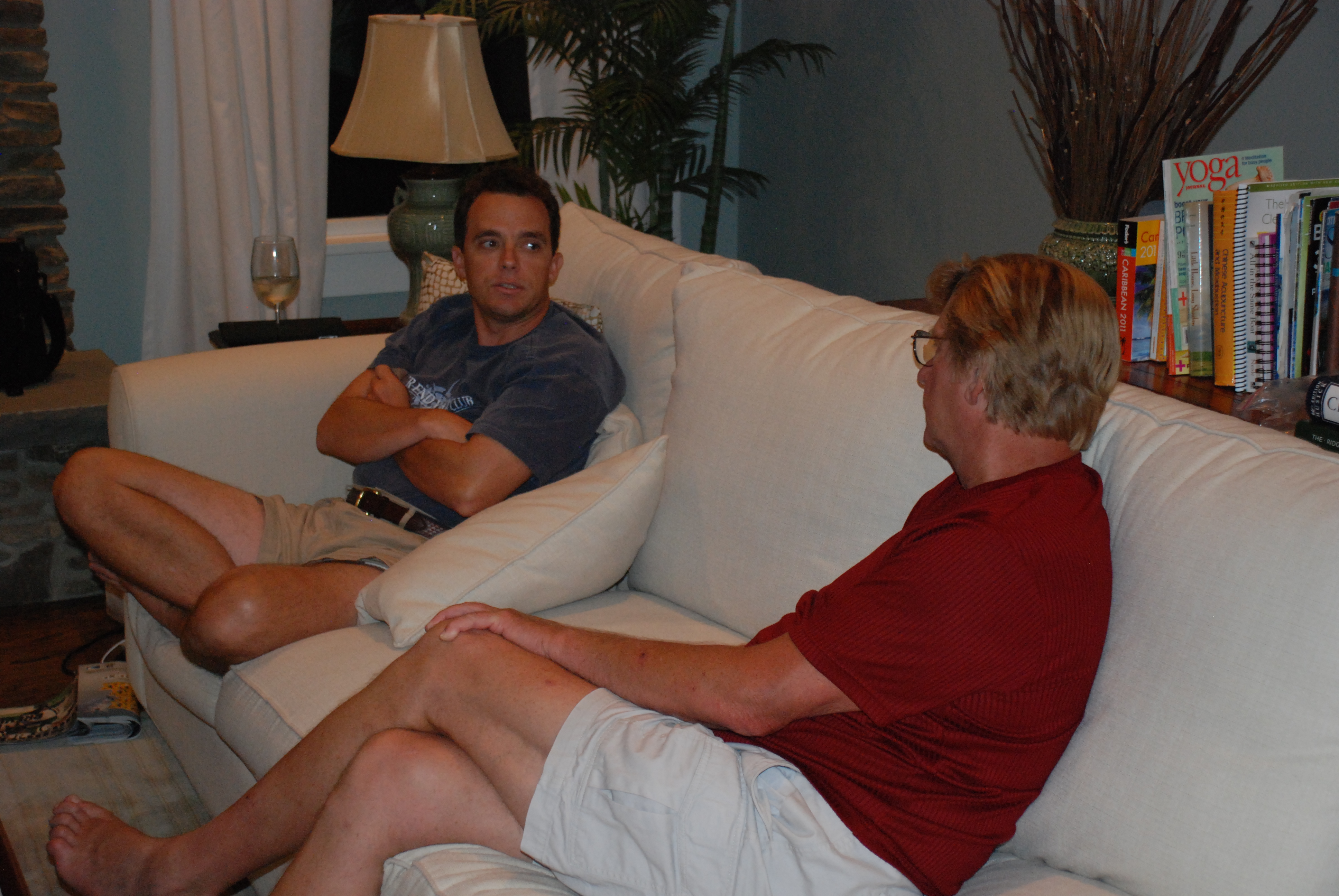(thanks to boatsafe.com)
It’s driving my boat friends/family crazy when I talk about our boat in layman’s terms to make it easier to understand. So I’m going to transition to the correct terminology and offer this little glossary for future reference, as if you have nothing to do but read my blog and look up obscure boating terms. Either way, it’s interesting to read through and see some of the common terms that have crept into English idiom usage over the last couple hundred years. Well, it’s interesting if you are a complete and utter geek, like me.
Oh, and if you don’t read through it, you won’t understand stories like this, which are sure to come: “We were moored at a beautiful lee anchorage. I was lounging up top in the aft cockpit. I went forward to check on the fouled ground tackle. The chocks were clear, but when I leaned on the brightwork and looked overboard at the waterline, I could see the bitter end of the rode and knew I had used too little scope. The anchor was aweigh and Patronus was adrift. I let out some slack, called to Chris for a sounding, and braced my foot on the forward hatch for some leverage as I set the anchor properly.” Which can be translated as, “I’m an idiot and I don’t know how to set an anchor. Now we are floating away.”
A ABAFT – Toward the rear (stern) of the boat. Behind.
ABEAM – At right angles to the keel of the boat, but not on the boat.
ABOARD – On or within the boat.
ABOVE DECK – On the deck (not over it – see ALOFT)
ABREAST – Side by side; by the side of.
ADRIFT – Loose, not on moorings or towline.
AFT – Toward the stern of the boat.
AGROUND – Touching or fast to the bottom.
AHEAD – In a forward direction.
AIDS TO NAVIGATION – Artificial objects to supplement natural landmarks indicating safe and unsafe waters.
ALEE – Away from the direction of the wind. Opposite of windward.
ALOFT – Above the deck of the boat.
AMIDSHIPS – In or toward the center of the boat.
ANCHORAGE – A place suitable for anchoring in relation to the wind, seas and bottom.
ASTERN – In back of the boat, opposite of ahead.
ATHWARTSHIPS – At right angles to the centerline of the boat; rowboat seats are generally athwart ships.
AWEIGH – The position of anchor as it is raised clear of the bottom.
B BATTEN DOWN – Secure hatches and loose objects both within the hull and on deck.
BEAM – The greatest width of the boat.
BEARING – The direction of an object expressed either as a true bearing as shown on the chart, or as a bearing relative to the heading of the boat.
BELOW – Beneath the deck.
BIGHT – The part of the rope or line, between the end and the standing part, on which a knot is formed.
BILGE – The interior of the hull below the floor boards.
BITTER END – The last part of a rope or chain.The inboard end of the anchor rode.
BOAT – A fairly indefinite term. A waterborne vehicle smaller than a ship. One definition is a small craft carried aboard a ship.
BOAT HOOK – A short shaft with a fitting at one end shaped to facilitate use in putting a line over a piling, recovering an object dropped overboard, or in pushing or fending off.
BOOT TOP – A painted line that indicates the designed waterline.
BOW – The forward part of a boat.
BOW LINE – A docking line leading from the bow.
BOWLINE – A knot used to form a temporary loop in the end of a line.
BRIDGE – The location from which a vessel is steered and its speed controlled. “Control Station” is really a more appropriate term for small craft.
BRIDLE – A line or wire secured at both ends in order to distribute a strain between two points.
BRIGHTWORK – Varnished woodwork and/or polished metal.
BULKHEAD – A vertical partition separating compartments.
BUOY – An anchored float used for marking a position on the water or a hazard or a shoal and for mooring.
BURDENED VESSEL – That vessel which, according to the applicable Navigation Rules, must give way to the privileged vessel. The term has been superseded by the term “give-way”.
C CABIN/BERTH/STATEROOM – A compartment for passengers or crew.
CAPSIZE – To turn over.
CAST OFF – To let go.
CATAMARAN – A twin-hulled boat, with hulls side by side.
CHAFING GEAR – Tubing or cloth wrapping used to protect a line from chafing on a rough surface.
CHART – A map for use by navigators.
CHINE – The intersection of the bottom and sides of a flat or v-bottomed boat.
CHOCK – A fitting through which anchor or mooring lines are led. Usually U-shaped to reduce chafe.
CLEAT – A fitting to which lines are made fast. The classic cleat to which lines are belayed is approximately anvil-shaped.
CLOVE HITCH – A knot for temporarily fastening a line to a spar or piling.
COAMING – A vertical piece around the edge of a cockpit, hatch, etc. to prevent water on deck from running below.
COCKPIT – An opening in the deck from which the boat is handled.
COIL – To lay a line down in circular turns.
COURSE – The direction in which a boat is steered.
CUDDY – A small shelter cabin in a boat.
CURRENT – The horizontal movement of water.
 D DEAD AHEAD – Directly ahead.
D DEAD AHEAD – Directly ahead.
DEAD ASTERN – Directly aft.
DECK – A permanent covering over a compartment, hull or any part thereof.
DINETTE – dining room table.
DINGHY – A small open boat. A dinghy is often used as a tender for a larger craft.
DISPLACEMENT – The weight of water displaced by a floating vessel, thus, a boat’s weight.
DOWN BELOW – inside the boat
DRAFT – The depth of water a boat draws.
E EBB – A receding current.
F FATHOM – Six feet.
FENDER – A cushion, placed between boats, or between a boat and a pier, to prevent damage.
FIGURE EIGHT KNOT – A knot in the form of a figure eight, placed in the end of a line to prevent the line from passing through a grommet or a block.
FLARE – The outward curve of a vessel’s sides near the bow. A distress signal.
FLOOD – An incoming current.
FOLLOWING SEA – An overtaking sea that comes from astern.
FOREPEAK – A compartment in the bow of a small boat.
FORWARD – Toward the bow of the boat.
FOULED – Any piece of equipment that is jammed or entangled, or dirtied.
FREEBOARD – The minimum vertical distance from the surface of the water to the gunwale.
G GALLEY – The kitchen area of a boat.
GANGWAY – The area of a ship’s side where people board and disembark.
GEAR – A general term for ropes, blocks, tackle and other equipment.
GENOA/JIB/SPINNAKER – the various sails of different sizes attached to the forestay (at the bow of the boat).
GIVE-WAY VESSEL – A term used to describe the vessel which must yield in meeting, crossing, or overtaking situations.
GRAB RAILS – Hand-hold fittings mounted on cabin tops and sides for personal safety when moving around the boat.
GROUND TACKLE – A collective term for the anchor and its associated gear.
GUNWALE – The upper edge of a boat’s sides.
H HARD CHINE – An abrupt intersection between the hull side and the hull bottom of a boat so constructed.
HATCH – An opening in a boat’s deck fitted with a watertight cover.
HEAD – A marine toilet. Also the upper corner of a triangular sail.
HEADING – The direction in which a vessel’s bow points at any given time.
HEADWAY – The forward motion of a boat. Opposite of sternway.
HELM – The wheel or tiller controlling the rudder.
HELMSPERSON – The person who steers the boat.
HITCH – A knot used to secure a rope to another object or to another rope, or to form a loop or a noose in a rope.
HOLD – A compartment below deck in a large vessel, used solely for carrying cargo.
HULL – The main body of a vessel.
I INBOARD – More toward the center of a vessel; inside; a motor fitted inside a boat.
INTRACOASTAL WATERWAY – ICW: bays, rivers, and canals along the coasts (such as the Atlantic and Gulf of Mexico coasts), connected so that vessels may travel without going into the sea.
J JETTY – A structure, usually masonry, projecting out from the shore; a jetty may protect a harbor entrance.
K KEEL – The centerline of a boat running fore and aft; the backbone of a vessel.
KNOT – A measure of speed equal to one nautical mile (6076 feet) per hour.
L LAZARETTE – A storage space in a boat’s stern area.
LEE – The side sheltered from the wind.
LEEWARD – The direction away from the wind. Opposite of windward.
LEEWAY – The sideways movement of the boat caused by either wind or current.
LINE – Rope and cordage used aboard a vessel.
LOG – A record of courses or operation. Also, a device to measure speed.
LUBBER’S LINE – A mark or permanent line on a compass indicating the direction forward parallel to the keel when properly installed.
M MAIN SAIL – the large sail aft of and attached to the mast.
MARLINSPIKE – A tool for opening the strands of a rope while splicing.
MAST – the tall spar on a sailboat that holds the sails.
MIDSHIP – Approximately in the location equally distant from the bow and stern.
MOORING – An arrangement for
securing a boat to a mooring buoy or a pier.
N NAUTICAL MILE – One minute of latitude; approximately 6076 feet – about 1/8 longer than the statute mile of 5280 feet.
NAVIGATION – The art and science of conducting a boat safely from one point to another.
NAVIGATION STATION (NAV STATION) – desk down below where electronics are displayed.
NAVIGATION RULES – The regulations governing the movement of vessels in relation to each other, generally called steering and sailing rules.
O OUTBOARD – Toward or beyond the boat’s sides. A detachable engine mounted on a boat’s stern.
OVERBOARD – Over the side or out of the boat.
P PILING – Support, protection for wharves, piers etc.; constructed of piles (see PILE)
PILOTING – Navigation by use of visible references, the depth of the water, etc.
PLANING – A boat is said to be planing when it is essentially moving over the top of the water rather than through the water.
PORT – The left side of a boat looking forward. A harbor.
PRIVELEGED VESSEL – A vessel which, according to the applicable Navigation Rule, has right-of-way (this term has been superseded by the term “stand-on”).
Q QUARTER – The sides of a boat aft of amidships.
QUARTERING SEA – Sea coming on a boat’s quarter.
R RODE – The anchor line and/or chain.
ROPE – In general, cordage as it is purchased at the store. When it comes aboard a vessel and is put to use it becomes line.
RUDDER – A vertical plate or board for steering a boat.
RUN – To allow a line to feed freely.
RUNNING LIGHTS – Lights required to be shown on boats underway between sundown and sunup.
S SALOON: living room
SATELLITE NAVIGATION – A form of position finding using radio transmissions from satellites with sophisticated on-board automatic equipment.
SCOPE – Technically, the ratio of length of anchor rode in use to the vertical distance from the bow of the vessel to the bottom of the water. Usually six to seven to one for calm weather and more scope in storm conditions.
SCREW – A boat’s propeller.
SCUPPERS – Drain holes on deck, in the toe rail, or in bulwarks or (with drain pipes) in the deck itself.
SEA COCK – A through hull valve, a shut off on a plumbing or drain pipe between the vessel’s interior and the sea.
SEAMANSHIP – All the arts and skills of boat handling, ranging from maintenence and repairs to piloting, sail handling, marlinespike work, and rigging.
SEA ROOM – A safe distance from the shore or other hazards.
SEAWORTHY – A boat or a boat’s gear able to meet the usual sea conditions.
SECURE – To make fast.
SET – Direction toward which the current is flowing.
SHEETS/HALYARDS/LINES: various ropes around the boat that serve different functions
SHIP – A larger vessel usually thought of as being used for ocean travel. A vessel able to carry a “boat” on board.
SLACK – Not fastened; loose. Also, to loosen.
SOLE – Cabin or saloon floor. Timber extensions on the bottom of the rudder. Also the molded fiberglass deck of a cockpit.
SOUNDING – A measurement of the depth of water.
SPRING LINE – A pivot line used in docking, undocking, or to prevent the boat from moving forward or astern while made fast to a dock.
SQUALL – A sudden, violent wind often accompanied by rain.
SQUARE KNOT – A knot used to join two lines of similar size. Also called a reef knot.
STANDING PART – That part of a line which is made fast.The main part of a line as distinguished from the bight and the end.
STAND-ON VESSEL – That vessel which has right-of-way during a meeting, crossing, or overtaking situation.
STARBOARD – The right side of a boat when looking forward.
STEM – The forward most part of the bow.
STERN – The after part of the boat.
STERN LINE – A docking line leading from the stern.
STOW – To put an item in its proper place.
SWAMP – To fill with water, but not settle to the bottom.
T THWARTSHIPS – At right angles to the centerline of the boat.
TIDE – The periodic rise and fall of water level in the oceans.
TILLER – A bar or handle for turning a boat’s rudder or an outboard motor.
TOPSIDES – The sides of a vessel between the waterline and the deck; sometimes referring to onto or above the deck.
TRANSOM – The stern cross-section of a square sterned boat.
TRIM – Fore and aft balance of a boat.
U UNDERWAY – Vessel in motion, i.e., when not moored, at anchor, or aground.
UP TOP: on deck
V V BOTTOM – A hull with the bottom section in the shape of a “V”.
W WAKE – Moving waves, track or path that a boat leaves behind it, when moving across the waters.
WATERLINE – A line painted on a hull which shows the point to which a boat sinks when it is properly trimmed (see BOOT TOP).
WAY – Movement of a vessel through the water such as headway, sternway or leeway.
WINDWARD – Toward the direction from which the wind is coming.
Y YACHT – A pleasure vessel, a pleasure boat; in American usage the idea of size and luxury is conveyed, either sail or power.
YAW – To swing or steer off course, as when running with a quartering sea.


![3716815_-1_20110922135200_0_0[1]](http://www.conwaysailors.com/wp-content/uploads/2012/03/3716815_-1_20110922135200_0_01.jpg)

 D DEAD AHEAD – Directly ahead.
D DEAD AHEAD – Directly ahead.